1.2 Materials, Processes, and Techniques in Prehistoric Art
7 min read•june 18, 2024
Riya Patel
AP Art History 🖼
34 resourcesSee Units
Introduction
During the period of global prehistory between 30,000 and 500 BCE, various cultures around the world were creating art using a variety of materials, processes, and techniques.
Materials: Some of the materials used for art during this time period included rock, such as sandstone, limestone, and granite, as well as clay, bone, ivory, and shells. Pigments, such as red and yellow ochre, charcoal, and manganese were also used to create color in art.
Processes: The processes used to create art during this time period varied depending on the medium. Rock art, for example, was created by carving or pecking designs into rock surfaces, while clay figurines were often modeled by hand. Pottery was created by shaping clay on a potter's wheel and then firing it in a kiln.
Techniques: Prehistoric artists used a variety of techniques to create their art during this time period. These included engraving, relief, and painting. They also used techniques such as stippling, cross-hatching, and perspective to create depth and texture in their art.
During this period, also many cultures were developing new technologies, such as metalworking, which allowed them to create art using new materials, such as bronze, gold and silver.
Camelid sacrum
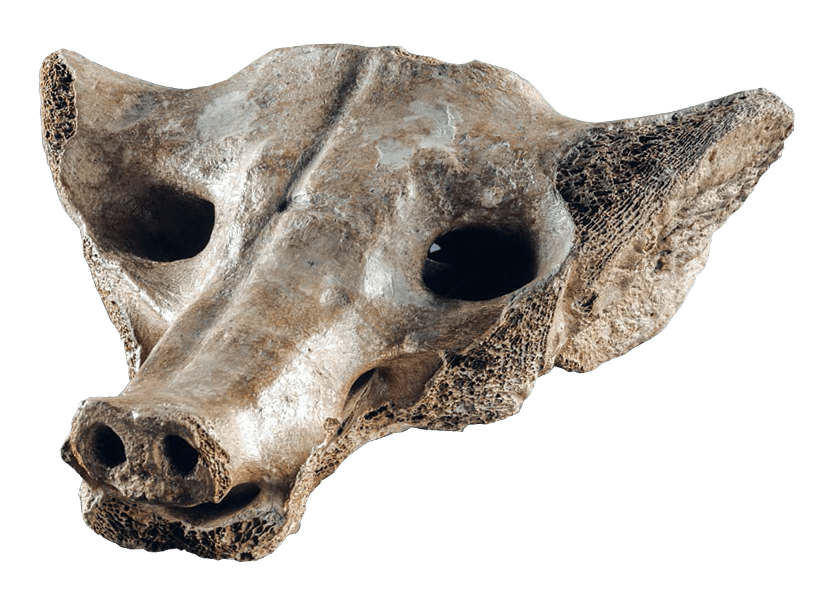
Courtesy of Obelisk Art History
A camelid sacrum is a piece of the pelvic bone (sacrum) of a camelid, that existed in the Camelidae family such as a llama or alpaca, which is often used in prehistoric art. These bones have a natural curved shape that makes them suitable for use in creating sculptures and other decorative items.
In pre-Columbian South America, the camelid sacrum was a common material used by ancient Andean cultures to create sculptures of animals such as pumas, snakes, and other animals. These sculptures were often used in religious ceremonies and burials. The sacrum was also used to create other decorative items such as masks, pendants, and even musical instruments.
It is considered a masterpiece of Moche art and a fine example of the use of camelid sacrum as a medium for art.
Running horned woman
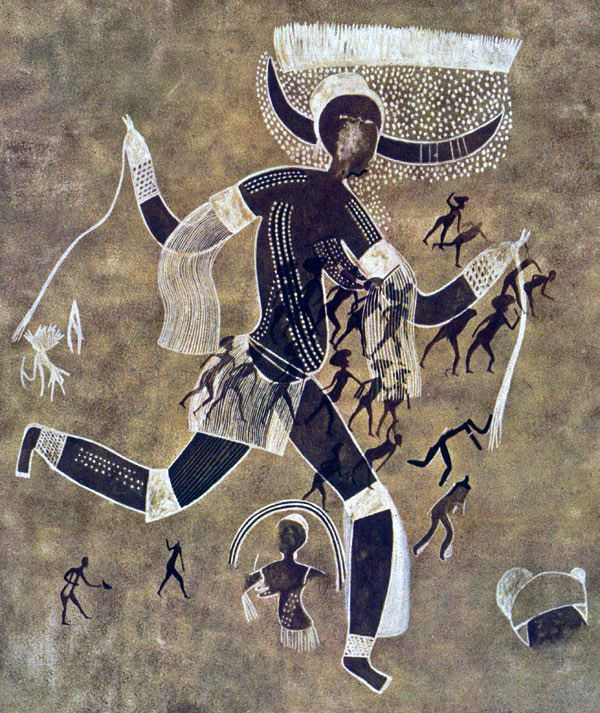
Courtesy of Khan Academy
The "Running Horned Woman" is a rock painting that was painted by using pigment and located in Algeria.
The painting depicts a woman with a headdress of two upward-curving horns, and she is running. She is also adorned with jewelry and clothing that suggest she is a person of high status. The details of the sculpture are quite realistic and the level of craftsmanship is quite high.
The Running Horned Woman is believed to have been used in religious rituals and ceremonies, possibly as an embodiment of a goddess or other supernatural being. The horns on the headdress may also symbolize power and authority.
The techniques used to create these painting varied depending on the culture and time period. They were often carved or shaped with stone tools, and then decorated with pigments such as charcoal or other materials.
Beaker with ibex motifs

Courtesy of Obelisk Art History
A "Beaker with ibex motifs" is a type of ancient ceramic pottery that features decorative designs of ibexes, which are a type of wild mountain goat found in Europe and Asia. These beakers are typically small in size and were used for drinking or for ritual purposes.
Ibex motifs were common in the art of the Beaker culture, which was a prehistoric culture that existed in Europe, primarily in the areas of modern-day Britain and the Netherlands, from around 2800 to 1800 BCE. The Beaker culture is known for its distinctive bell-shaped pottery, which was often decorated with geometric patterns and animal motifs, including the ibex.
The beaker with ibex motifs were made by shaping the pottery and then decorating it with the ibex motifs, which were created by incising the design into the surface of the pottery. The pottery was then fired to harden it and create a finished product.
Anthropomorphic stele
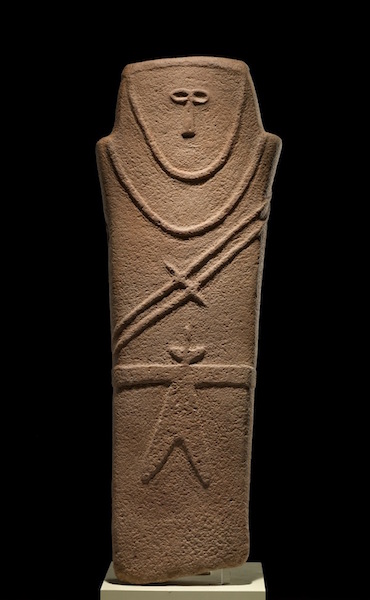
Courtesy of Khan Academy
An anthropomorphic stele is a type of stone monument that features a human or human-like figure. These figures can be carved in relief, or in the round, and they often have symbolic or religious significance.
Anthropomorphic steles have been found in many ancient cultures around the world, including Egypt, Mesoamerica, and the ancient Near East.
In ancient Egypt, anthropomorphic steles were often used to commemorate important individuals, such as pharaohs or high-ranking officials. They were typically made of granite or basalt and were often inscribed with hieroglyphs, which provided information about the person being commemorated.
In Mesoamerica, anthropomorphic steles were created by ancient Maya and Olmec cultures, which flourished in present-day Mexico and Central America between around 2000 BCE and 1500 CE. These steles were often carved with images of gods and rulers, and they were used to commemorate important events or to mark sacred sites.
In the ancient Near East, anthropomorphic steles were used to commemorate and honor the dead, and to mark the graves or tombs of important individuals.
Jade cong
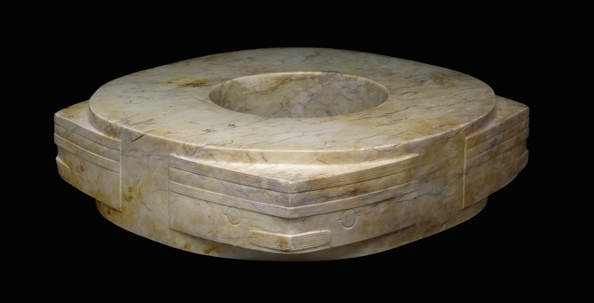
Courtesy of Khan Academy
A "jade cong" is a type of ancient Chinese jade artifact that was typically used in ritual or ceremonial contexts. The cong is a hollow tube-like object that was made from various types of jade, including nephrite, and it is often decorated with intricate designs and patterns.
The cong is believed to have been created during the Neolithic period in China, around the late 4th millennium BCE and it was used for centuries to come, during the Xia, Shang and Zhou dynasty.
Jade congs were highly valued by ancient Chinese cultures for their beauty and durability, as well as for their symbolic significance. They were often buried with the dead as grave goods and were believed to have protective powers. The designs and patterns carved into the congs were thought to have spiritual or religious meaning.
The cong is believed to be the oldest Chinese jade artifact, and it is considered to be one of the most important symbols of Chinese culture. It is believed that cong represents the connection between earth and heaven, and the circular shape of the cong, which is seen as a symbol of unity and continuity, is also thought to represent the cyclical nature of time.
Terra cotta fragment
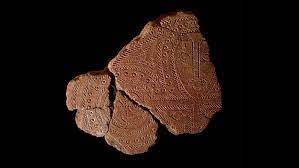
Courtesy of Khan Academy
A "terra cotta fragment" is a piece of pottery made from clay that has been fired at high temperatures. "Terra cotta" is a type of earthenware that is typically a reddish-brown color, and it is known for its durability and low cost of production.
Terra cotta fragments are often found in archaeological sites and are believed to be pieces of larger objects that have been broken or shattered over time. These fragments can include pottery, sculptures, and architectural elements.
One of the most famous examples of terra cotta fragments is the Terracotta Army of China, which is a collection of thousands of life-size terra cotta soldiers and horses that were buried with the first emperor of China, Qin Shi Huang, to protect him in the afterlife.
Terracotta fragments were also used in ancient Greece and Rome, where they were used in the production of pottery and terracotta figurines. These figurines were often used in religious rituals and were made to represent gods, goddesses, and other mythological figures.
Summary
Camelid sacrum is a sculpture made from camelid sacrum, specifically from the pelvic bone, created by the Moche culture of ancient Peru, it is believed to have been used in religious rituals and ceremonies, and it is considered a masterpiece of Moche art and a fine example of the use of camelid sacrum as a medium for art.
The Running Horned Woman is a rock painting & located in Algeria. It was likely made by carving into the stone with the use of stone-tools and later painted using pigments such as charcoal. It's possible that this was painting portrayed a goddess and used in religious ceremonies or burials.
Beaker with ibex motifs is a type of ancient ceramic pottery that features decorative designs of ibexes. They were commonly used by Beaker culture and were made by shaping the pottery and then decorating it with the ibex motifs, which were created by incising the design into the surface of the pottery. The pottery was then fired to harden it and create a finished product.
Anthropomorphic stele is a type of stone monument that features a human or human-like figure, it has been found in many ancient cultures around the world, including Egypt, Mesoamerica, and the ancient Near East. They were often used to commemorate important individuals, such as pharaohs or high-ranking officials, gods and rulers and to mark sacred sites or to mark the graves or tombs of important individuals.
A Jade cong is a type of ancient Chinese jade artifact that was typically used in ritual or ceremonial contexts. The cong is a hollow tube-like object that was made from various types of jade, including nephrite and it is often decorated with intricate designs and patterns. It was valued for its beauty and durability, as well as for its symbolic significance and it was often buried with the dead as grave goods, and was believed to have protective powers. It is considered one of the most important symbols of Chinese culture and represents the connection between earth and heaven and the circular shape of the cong, which is seen as a symbol of unity and continuity.
Terra cotta fragment is a piece of pottery made from clay that has been fired at high temperatures, that is typically reddish-brown in color and known for its durability and low cost of production. Terra cotta fragments are often found in archaeological sites and are believed to be pieces of larger objects that have been broken or shattered over time and they can include pottery, sculptures, and architectural elements. The Terracotta Army of China is a famous example of terra cotta fragments and they were also used in ancient Greece and Rome, where they were used in the production of pottery and terracotta figurines.
Browse Study Guides By Unit
🗿Unit 1 – Global Prehistoric Art, 30,000-500 BCE
🏛Unit 2 – Ancient Mediterranean Art, 3500-300 BCE
⛪️Unit 3 – Early European and Colonial American Art, 200-1750 CE
⚔️Unit 4 – Later European and American Art, 1750-1980 CE
🌽Unit 5 – Indigenous American Art, 1000 BCE-1980 CE
⚱️Unit 6 – African Art, 1100-1980 CE
🕌Unit 7 – West and Central Asian Art, 500 BCE-1980 CE
🛕Unit 8 – South, East, and Southeast Asian Art, 300 BCE-1980 CE
🐚Unit 9: The Pacific, 700–1980 ce
🏢Unit 10 – Global Contemporary Art, 1980 CE to Present
📚Study Tools

Fiveable
Resources
© 2025 Fiveable Inc. All rights reserved.